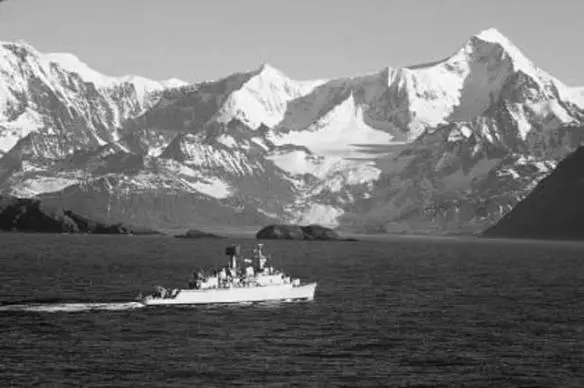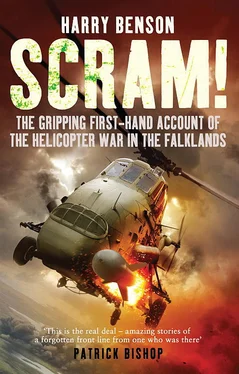The three Wessex set off again with conditions improved from the overnight storm to a mere gale. Stanley led in the Wessex 3 with Georgeson and Tidd following, having decided that he couldn’t put Andy Pulford through a second dose of Fortuna Glacier. As the formation approached the foot of the glacier, Stanley told the two other aircraft to land on a flat promontory and wait while he recced the mountain. Violent changes in wind direction made it hard for Stanley to control his tail rotor as he climbed the glacier. He decided to abort the recce and recalled the other aircraft back to the ships for a refuel. An hour later, at lunchtime, the trio set off for a further attempt. This time the weather was clearer and calmer as the rescue team landed next to the orange smokes set off by the SAS teams on top of the glacier. Under normal circumstances conditions would have been considered appalling. The wind was gusting to sixty knots. The aircraft were still sliding around on the ice.
In the back of Yankee Foxtrot, Tug Wilson had closed the door and was pouring hot soup out for the frozen SAS troops. Mike Tidd made his fateful call for permission to go while the going was good.
Aside from the loss of the two troop-carrying Wessex 5s, junglie involvement in the taking of South Georgia was otherwise minimal. For the next few days, Tidd and Georgeson made themselves useful on board Antrim . However, an important and unusual role lay ahead.
Having discovered that the route over the top of Fortuna Glacier was impassable, the SAS now attempted to insert their patrols covertly in rubber inflatable Gemini boats. This method resulted in no greater success. Ian Stanley and his crew spent a day searching for and rescuing broken down Geminis that were now floating around the freezing Antarctic waters.
To the Royal Navy aircrew, the SAS were a peculiar bunch and a law unto themselves. Having refused to speak to anyone or take advice beforehand, suddenly they were now everybody’s best friends. Maybe it was the relief at surviving near disasters. Maybe it was the camaraderie of having been into battle together, at least against the weather. The Wessex aircrew were even invited onto the subsequent assault, causing Jan Lomas to comment afterwards that ‘the SAS were lovely!’
Three days after the crash on Fortuna Glacier came news that an Argentine Guppy-class submarine was in the area. The ARA Santa Fe had already landed a party of marines at South Georgia and now posed a serious threat to the British surface fleet. On the morning of Sunday 25 April, the Wessex 3 crew spotted the Santa Fe on the surface leaving Grytviken in gloomy weather conditions. Ian Stanley immediately ran in from behind the submarine at low level, lobbing two depth charges into the water just ahead of it. As the Wessex banked hard to clear away from the area, the crew strained their heads behind them to watch the outcome of the attack.
The effect was dramatic. Huge explosions in the water blew the rear half of the submarine completely out of the water, its tail hanging suspended in the air before crashing back down into the sea. Amazingly the submarine remained afloat, although it had turned, zigzagging its way back towards land. From the Wessex 3 cabin, Fitz Fitzgerald fired his entire supply of machine-gun ammunition into the conning tower of the submarine. Shortly afterwards, HMS Brilliant ’s Lynx arrived on the scene, dropping a Mark 46 torpedo into the water alongside the surfaced submarine without effect. They followed up with their own burst of machine-gun fire, steering away when fire was returned at them from the tower of the submarine.
Next on the scene was Tony Ellerbeck in HMS Endurance ’s Wasp helicopter. Sighting the submarine’s fin from two miles away, the Wasp launched one of its AS12 anti-ship missiles. From the left seat, aimer David Wells directed the wire-guided missile directly into the fin. The missile passed straight through the thin skin exploding in the sea on the other side. The impact was enough to blow the Argentine machine gunner off his firing position and down into the control room below. The second missile was not as successful.
In the air, the attack threatened to degenerate into chaos. The two Endurance Wasps couldn’t talk to anyone else because they had a different radio fit. Their first missile attack had therefore taken the Lynx crew completely by surprise. Brilliant ’s second Lynx now appeared, circling overhead whilst firing her machine gun into the submarine hull. Meanwhile Tony Ellerbeck’s Wasp returned to Endurance and rearmed with two more missiles, launching both in quick succession. This time the first missile flew into the sea whilst the second went through the submarine fin.
A second Wasp, flown by John Dransfield from HMS Plymouth , now had a crack with its single AS12 missile. Aimer Joe Harper guided his missile right onto the submarine itself, exploding so close that it caused further damage to the hull.
By now the submarine was approaching the jetty at Grytviken. Machine-gun tracer fire was streaking in all directions, coming up from the Argentine ground forces and down from the helicopters. A third Wasp, also from Endurance and flown by Tim Finding, now lined up for the attack. His aimer, Bob Nadin, achieved a miss with his first missile and a hit with his second on Santa Fe ’s fin.
Six helicopters were now competing exuberantly for the prize of sinking the Argentine submarine. As it became obvious that the sub was limping back to the pier at King Edward Point, the helicopters began to withdraw away from the ground fire. Santa Fe and her sixty-man crew were going nowhere. However, Tony Ellerbeck wasn’t finished, having rearmed and returned for his third attack. The first missile failed to fire, but the second hit the fin, this time exploding noisily. Eight missiles, one torpedo and a whole load of machine-gun bullets had now been fired at the Santa Fe . But it was the original two depth charges that did the damage.
In order to sustain the momentum of this attack, it was decided to begin the land assault straight away. The main body of troops had been held off in RFA Tidespring to avoid the submarine threat. So a hastily assembled landing force combining SAS, SBS and Royal Marines was flown in by the Antrim Wessex and both of Brilliant ’s Lynx. Mike Tidd and Ian Georgeson organised the flow of troops to the flight deck in order to free up extra Royal Marines. The Royal Navy warships sailed towards Grytviken firing their guns and with their huge battle ensigns flying. It was a stirring sight, even if Antrim ’s ensign did wrap itself around the radar mast.

The destroyer HMS Antrim sails towards Mount Paget in South Georgia. In this bay, Antrim ’s Wessex 3 blew the Argentine submarine Santa Fe out of the water with two depth charges. Various Wasp helicopters then followed up with an enthusiastic, but largely futile, volley of AS12 missiles.
Demoralised by the intensity of the naval gunfire barrage and the reappearance of their damaged submarine, the Argentine garrison surrendered as the landing force approached. Shortly afterwards, the British Prime Minister Margaret Thatcher was able to stand on the steps of 10 Downing Street and read out the emotive signal sent by HMS Antrim ’s Captain Brian Young. ‘Be pleased to inform Her Majesty that the White Ensign flies alongside the Union Flag in Grytviken South Georgia. God save the Queen.’
* * *
Having run out of helicopters, Mike Tidd realised that his team were the obvious choice to look after the Argentine prisoners from the garrison and Santa Fe . Young was grateful for the offer. The junglies could make themselves useful again.
Читать дальше













